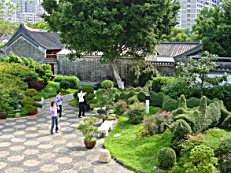Kowloon Walled City Park
Overview
The Kowloon Walled City Park occupies one of the most historic sites in the territory. Once strategically located at the north-eastern corner of the Kowloon peninsula and adjacent to what was to become Kowloon Bay, the site was used by imperial officials in the 15th century and was first fortified in 1668 when a signal station was established there. About 1810, a small fort was built at the head of the beach which then adjoined the site. The importance of the area to China's maritime defences grew sharply following the British occupation of Hong Kong Island in 1841. Between 25th November 1846 and 31st May 1847, a walled garrison-city was constructed. Massive stone walls with six watchtowers and four gates enclosed the area, which measured about 6.5 acres.
The interior was dominated by the offices of the Commodore of the Dapeng Brigade, and the Kowloon Assistant Military Inspectorate, commonly known as 'Yamen'. In addition, there were more than ten numbers of military buildings including soldiers' quarters, gunpowder and ordnance magazines. Besides, some civilian houses could also be found in the City. The strength of the troops stationed there were 250 at the time of the completion of the City, which increased subsequently to more than 500 in 1898/99.
In 1898, the New Territories were leased to the British for a term of 99 years. At first, Qing officials still continued to station in the City. In 1899, however, British troops were sent to take over the City, and the Qing officials and soldiers were expelled. The resultant vacuum of civil order from 1899 laid the seeds for the eventual deterioration of the area into a semi-lawless enclave and festering squatter slum.
During the Japanese occupation of 1941-45 the wall was torn down and the stone used to extend the nearby Kai Tak airfield. An idea of the large amount of quarried granite so gained is provided by the wall's dimensions: 15 feet wide and 13 feet high for a gross length of 2,200 feet, plus a supplementary wall which ran Great Wall-style from the northern rampart to the top of the hill which formerly overlooked the garrison.
After the war, high-rise tenements built without authority and completely lacking proper foundations mushroomed cheek by jowl over almost the whole site, and the Walled City with its dank alleyways became a notorious nest of drug divans, criminal hide-outs, vice dens and even cheap, unlicensed dentists.
In 1987, with the agreement of the Chinese authorities, the decision was taken to clear the area and build a park on the site which would incorporate as many remaining features as possible of the original buildings and other features.
Demolition was completed in April 1994 and despite decades of neglect and mis-use of the site, a rewarding number of relics was unearthed, nearly all of which were incorporated in the design or preserved as exhibits.
The main discoveries were two carved granite plaques from the original South Gate, which had been the main entrance, one bearing the characters for "South Gate" and the other "Kowloon Walled City".
Other remnants included the foundation of the former wall, the foundations of the South and East Gates, and a flag-stone path next to the drainage ditch running along the foot of the inner wall. Other relics included three old cannons, stone lintels and couplets, and column bases.
The design of the park was inspired by the Jiangnan garden style of the early Qing Dynasty. Construction began in May 1994, with a work-force of skilled artisans from the Mainland being employed to ensure accurate reproduction of the classical concept.
Work was completed in August 1995, and the park was officially opened on December 22, 1995, by the Governor, the Rt. Hon. Christopher Patten.
The park covers 31,000 square metres and is divided into eight scenic zones with individual characteristics but blending into the overall design.
It was built at a cost of $76 million and is managed by the Leisure and Cultural Services Department.
The design of the Kowloon Walled City Park is based on the Jiangnan garden style of the early Qing Dynasty.
It was chosen by architects of the Architectural Services Department following a visit to China to select the most appropriate design for the historic site. Subsequently, the project was awarded a Diploma at the IGO Stuttgart EXPO 93 (International Garden Exposition).
The design is divided into eight landscape features which complement one another and subtly blend into the overall layout. The centerpiece is of course the Yamen, a fully restored three-hall structure offering a glimpse of the physical appearance of the one-time walled garrison-city.
Location:
Comments
Connections
- Kowloon
-
- Hong Kong
-
- Kowloon
- Hong Kong
- SorocabaBrazil
- ClevelandUnited States
- Cluj NapocaRomania
- New York City
- EringsbodaSweden
- San FranciscoUnited States
- St. LouisUnited States
- New YorkUnited States
- San FranciscoUnited States
- Brazil
- United States
- Jersey CityUnited States
- United States
- 독일
- Long Island CityUnited States
- KarlskronaSweden
- New yorkUnited States
- San AntonioUnited States
- United States
- United States
- United States
- United States
- Jersey CItyUnited States
- Aruba
- NewtonvilleUnited States
Multimedia

Kowloon Walled City Park

Impacts
No impacts have been left for this site yet - be the first!










